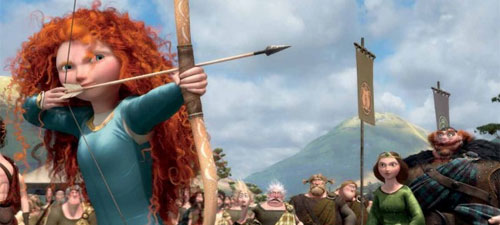
Pixar’s Brave has received a mixed critical response. Well, now that the dust has settled and the internet has gone on to complain about new things, I thought it might be an apt time to examine film in more detail. Now, granted I’m sure many of you are already exceedingly weary of all the Brave chatter and articles, but a movie such as this fascinates me. For one, as the CinemaScore would suggest, Brave isn’t a bad movie–it’s just a spectacularly mediocre one; as Douglas Adams would say, “mostly harmless.” Well, considering this is coming from the studio that has produced over the past 17 years a voluminous cannon of movies unmatched by anybody else in Hollywood, mediocre just doesn’t cut it for me. But, in what is probably the larger point, it could have been so good.
So, let’s make Brave good. Instead of just criticizing what doesn’t work, let’s workshop this sucker until it actually does. Here it is, ladies and germs, the Top 10 Ways to Fix Pixar’s Brave.
(Obviously, massive spoilers are below)
6.) Get into the action!
Yeah…yeah…it’s an ancient screenwriting tip: start in medias res. I’m not reinventing the wheel here. But, Brave would have really benefited from cutting a good 10 to 15 minutes from its first act, and basically starting with the scene where Merida is “auditioning” her suitors. Instead, we get a lot of exposition of her being a free spirit, including an opening song montage. I suppose you could argue that all this Bohemian frolicking is used to develop Merida’s character, but honestly, is her character really that deep? She’s a Princess who is being forced to live a life she does not want. Holy crap, is that a cliché starting point! Major props to Pixar for giving us a female centric lead character. That still doesn’t excuse the fact that she’s a walking stock character (C’mon! Splitting the arrow! Mel Brooks killed that shtick 19 years ago with Robin Hood Men in Tights). Brave shouldn’t waste so much time examining the fact that she’s an unconventional princess, because that’s not really what the movie is about. The film is about a mother and daughter learning to understand each other (think Finding Nemo with reversed gender roles). So, from a story point, get to the Suitor competition earlier, have her visit the Witch sooner, have the Bear/Mother transformation happen earlier, and ultimately, give yourself some more script space for…..
5.) Mother and Daughter Bonding Time
For a movie that is so conventional in its structure, Brave feels oddly misshapen. The first act is far too long, whereas the second and third act are improperly developed. The best scene in the movie occurs when Merida and Mother Bear (Queen Elinor) fish with one another. They are bonding–developing and rebuilding a relationship. However, essentially, the directors have their relationship change within that single scene. Granted, I like a Rocky-montage as much as the next guy, but Brave should have been about the adventure and journey that mother and daughter go on together. Instead of one scene, have it be several: show them in peril together, make them work together. Show how both Merida’s free spirited ways and Momma’s conservative teachings can be fused together so each takes the best from one another. There’s a shot after the fishing sequence where the camera jibs up to the landscape showing a lengthy path of wisps indicating a long and perilous journey. But, we as the audience never get to see that journey–we literally jump cut to them arriving at their destination. That’s the equivalent of Sam and Frodo looking at Mount Doom in the distance and then immediately arriving at the peak in the next scene, turning to each other and exclaiming “Gosh, I’m pooped! What a long walk!” As a result, the sequence in the cave where Merida and Queen Elinor confront the evil bear, Mor’du, ends up just being the next step in their journey, instead of the climax. Funny thing is, the screenwriters of the film understand this larger point on a macro level as we see the results of “mother/daughter bonding time” when Merida gives the speech in the banquet hall. The problem is that the film doesn’t earn the moment. It happens because the plot needs it to happen, not because the characters have actually learned and grown together.
4.) More Menace
Behind every great fairytale is an even better villain. Think of Scar from the Lion King. Now, THAT’S evil. The bear Mor’du doesn’t cut it because, frankly, he doesn’t do enough. The most frustrating thing is that the framework is there. I mean, essentially, the story implies he destroyed the Scottish kingdoms by turning against the other leaders. Wouldn’t it be cool if he had a more developed arc, where he is attempting to destroy the four kingdoms because he knows that, as a bear, he could never lead them? It’s the ole’ idea that if he can’t rule, then nobody can. Not only would this have added much needed complexity and depth to the plot, but it would have made his ultimate death more substantial. Plus, it would mean that Merida fought for something more than just herself and her personal mistakes.
3.) Even Magic Needs Rules
The weird thing about us moviegoers is that we are willing to believe anything on screen as long as such things operate within clearly defined rules. Brave never establishes these boundaries. Magic happens. That’s it. How do the wisps work? How do they appear? Why two sunsets until the bear spell is permanent? Why, of all animals, does the witch turn people into bears? Why does the witch’s home change locations? Brave seems far too content to answer all these questions with a nonchalant shrug of magic and pixie dust. That’s not a good enough answer for me. The movie needs to make decisions supported by rules. I’m not saying to ditch the fantastical elements altogether, but at least have the courtesy to define them.
2.) Characters, Not Mechanisms
Brave suffers from a big problem: its characters often act as plot mechanisms instead of…you know…actual characters. The biggest offender is the Witch. She’s not integrated into the story whatsoever. She appears, makes her magic cake, and then–poof–she’s never seen again. Not only does this introduce the odd question of why there is a wood-whittling, bear obsessed Witch in the middle of the forest, it also means her character only serves as a stepping stone to the next plot point. How do you fix this? I say ditch the witch (hey, that rhymed!) all together. With the introduction of the wisps it’s made clear that there is magic in the world. It would be much more interesting if the wisps themselves were responsible for the mother’s transformation. Instead of introducing more ancillary characters, use what’s already established in our defined magical world (i.e. see above) to incite change.
The same problem exists with several other characters, especially the three clan leaders and their respective Suitors. While I definitely admire Brave for not giving us a cliche “prince” for Merida to fall in love with, do all the firstborn sons have to be so useless? If we revisit the idea of Mor’du as a more substantive villain, perhaps the three suitors can help Merida in the third act as she faces Mr. Evil Bear head-on. Merida and the Suitors could work and fight together, protecting the kingdom as a unified team, each using their respective strengths to come out on top. Not only would this give the movie a much needed action set piece (ala the Monsters Inc. door sequence or the final fight in the Incredibles), it would also allow Merida to gain the trust and respect of the Suitors and the clans, even if she’s still not willing to give up her hand.
1.) Girl Power, Not Jerk Power
Maybe I’m crazy here, but Merida comes off as kind of a jerk. Granted, I get that she’s a strong woman who is being unfairly oppressed by societal norms. Still, she essentially gives her mother a poisoned cake that has completely unknown effects. Heck, it could have killed the Queen for all she knew. And then, to top it off, she doesn’t feel that sorry about it–after Mom becomes a bear she immediately blames the Witch instead of herself. While we eventually get a muffled apology from Merida at the end, it feels tacked on and forced. Merida never really changes as essentially she sort of gets what she wants without any negative consequences. Merida’s arc should be that of changing from a free spirited selfish girl, to a free-spirited and courageous leader. And, we as an audience need to watch that change happen in real time. If her arc would have been constructed that way, as the sun rises at the end, we would feel genuine emotion, instead of being told to feel genuine emotion. Now, that, ladies and gentleman, is the Pixar magic.
Whew! We did it! Brave is now a much better movie. Pixar, be sure to send all subsequent royalties my way. I accept pay pal.
